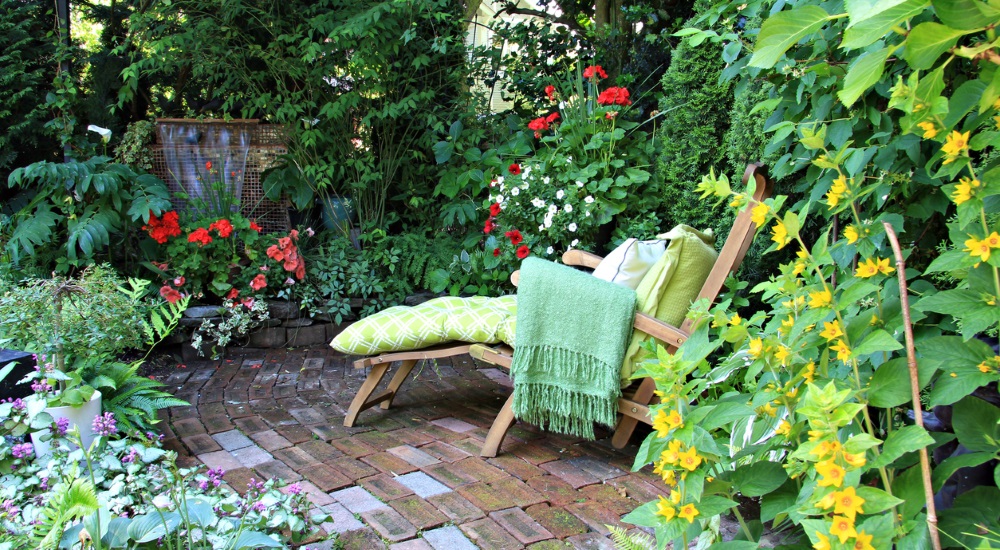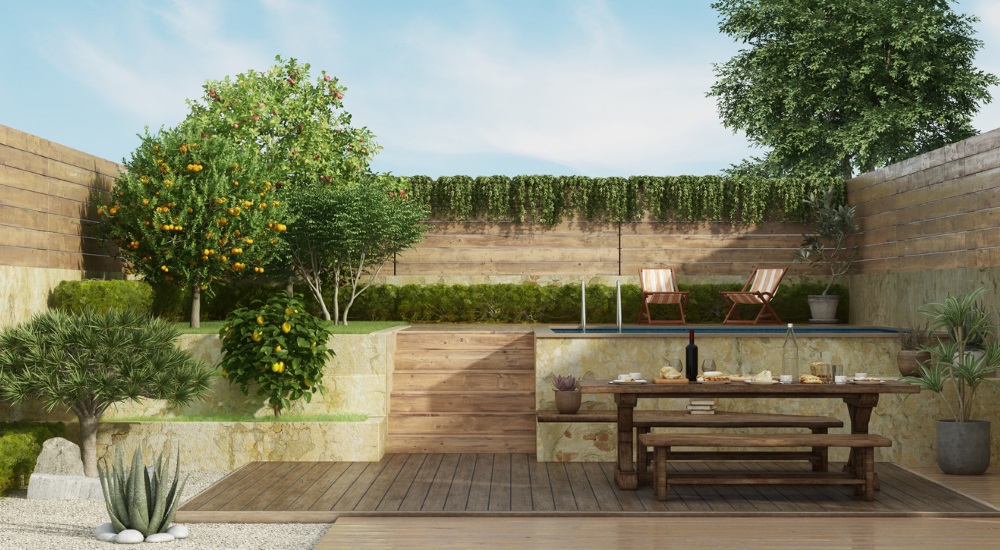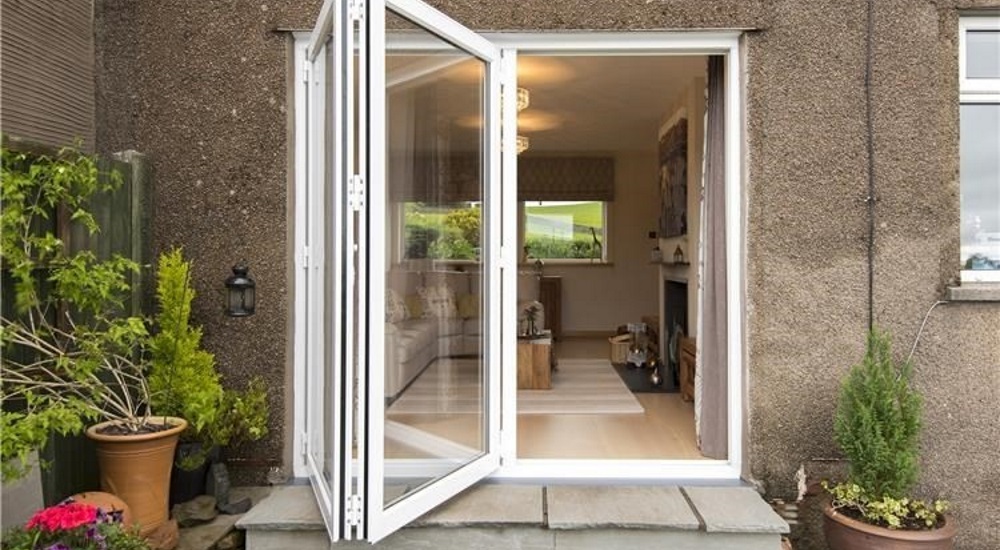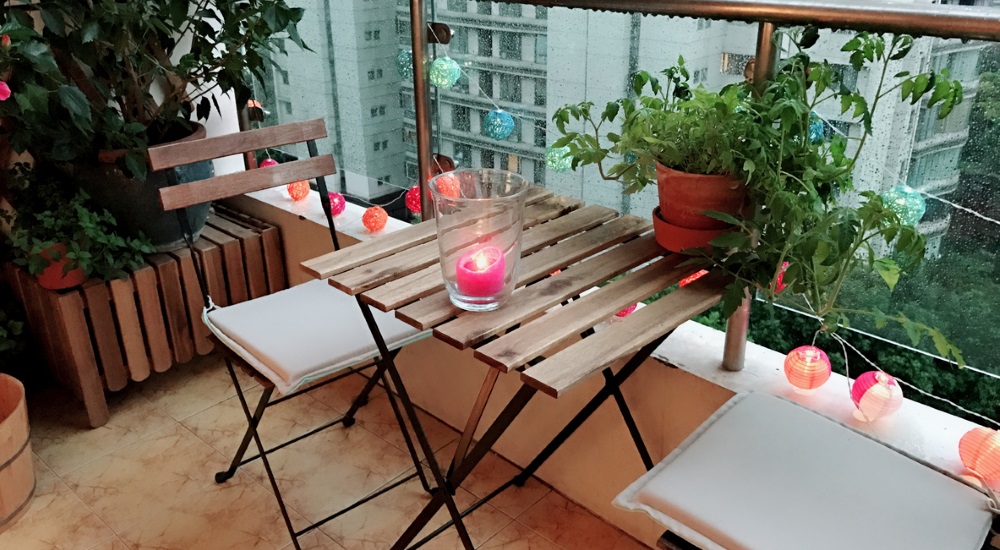Every home benefits from having an area of useable outdoor space, be that a garden, terrace or balcony. With a bit of considerate planning and styling, even the smallest of plots can provide a haven for relaxation—an invaluable addition to any home, particularly in built-up areas.
Whether you enjoy nurturing pot plants, entertaining al fresco or simply being able to access the outdoors for a quick cuppa and a bit of headspace, there are lots of small adaptations that you can do to bring your outside space to life.
To find out more, we spoke to experts across four different industries: Landscape gardening, interior design, construction, and property sales and letting.
Here’s what they had to say…

Tim Taylor – Landscape Gardener
As a landscape gardener, Tim Taylor is often challenged with transforming gardens and terraces to make the most of the available space. Here, he shares his tips and advice on working with a limited footprint…
How would you advise creating the maximum impact in a garden with limited space?
A common misconception when working with a small garden is that you should keep planting to a minimum, but it is actually better to do the opposite. Covering walls with plants will break up edges and soften corners, ultimately making the space feel more inviting.
Using a selection of smaller and larger plants will give both height and ground coverage. Clusters of pots can look lovely in corners, starting with a larger pot at the back and staggering down to smaller pots at the front.
Living walls are also great for bringing colour and interest to a small plot. In some cases, they can double or even triple your planting space. To minimise maintenance, integrate an irrigation system and use small plants such as herbs, which are easily replaceable.
What features would you recommend for making the most of all available outdoor space?
Having doors that open straight onto a space means that you will definitely use it more. Bi-fold and sliding doors are ideal for maximising space as they either stack into a small area or with sliding doors, all operation takes place on the one track, so nothing protrudes into the outside area. French doors may limit where you can plant as the footprint of where the door opens is unusable. Outdoor seating areas can be created in the smallest of spaces, so be creative with the area directly outside your house.
In terms of creating the illusion of more space, infinity water features filled to the brim with still water can create an amazing effect; the still water acts as a kind of mirror and will reflect the surrounding garden, giving the impression that it is bigger than it is. If space doesn’t allow for a body of water, think about including a vertical water feature and create interest through the sound of running or bubbling water.
Can you suggest any space-saving tips or advice for styling a balcony/terrace with a small footprint?
Think about the space before cluttering it with lots of small pots - place them strategically in just one corner or use a couple of large statement pots in the corners. You could also build long, thin planters around the perimeter of the space. Also, look at ways of incorporating greenery above floor level—you can get planters that are specifically designed to hang over balcony railings, and hanging baskets can add an instant burst of colour.
Choose chairs and tables that can be folded away when not in use. That way, you can look out at plants rather than furniture.
What plants are best suited to smaller pots and planters?
The type of plants that you choose largely depends on which way the terrace or balcony faces. For example, north-facing spaces will require hardier plants, whereas south facing spots are more forgiving.
Lasagna planting works brilliantly in small spaces. This is when you plant different bulbs in the same area, so that you have a continuation of colour throughout the year. This could be as simple as daffodils in the spring, followed by tulips, then dahlias in the summer. Do your research and have a play around with colour schemes. The beauty of this type of planting is that all the hard work is done at once, meaning you can sit back and enjoy it come to life throughout the year.
When choosing your pots and planters, it’s nice to have a variety of sizes and heights. It can be really effective to stack pots on top of each other (decreasing in size), so plants can flow over and around each other. Turn square-edged pots on an angle (when positioned on top of each other) to create triangular planting pockets. Trailing ivy and petunias look great in this type of planting arrangement.
Stacking also works well with cascading strawberries and is also an effective way of keeping them off the ground.
How would you suggest incorporating colour and greenery into a balcony? Does an elevated position restrict the choices to particularly hardy plants?
A simple way to protect plants in an elevated position is with bamboo screening. This will soften the wind flow and also can be helpful if you want to incorporate a climbing plant—such as clematis or honeysuckle—into the space. These can easily be trained to climb around a balcony and can look really effective.
Again, stagger different sized pots out from the corner of the balcony. Colour annuals—which are sold to be in bloom at that moment— are ideal for achieving instant colour. They have quite a short life expectancy, but are cheap and easy to replace. Try to avoid planting annuals and perennials together as you may disturb the perennials when removing the annuals.
Conifers are quite hardy and can look really nice when planted in pots and positioned in the corners of a balcony. In winter, they can be decorated with outdoor fairy lights and can even be used as mini Christmas trees. This is a good way to retain interest on the balcony during the bleaker months.
Any other tips?
Don’t be put off by a small garden. In fact, smaller spaces are often better for year-round use. Walled gardens will naturally be more protected from the wind, and can be further weather-proofed with a pergola or awning. Outdoor heating, such as a chimenea or fire pit, will make the space cosy—add some storm lanterns and a few warm blankets and you have an instant year-round garden!

Gilly Craft—Interior Designer
Careful planning and zoning can help make the most of any space both inside and out, especially when space is limited. President of the British Institute of Interior Designer, Gilly Craft explains how…
How would you suggest styling a small garden, terrace or balcony?
Even the tiniest of spaces can be zoned. Plan out the area before you start. Layer the planting to give interest and make sure you have a space to sit and enjoy the outside space. If you have a nice view, then make that the focal point. If you don’t, then make sure that anything untidy or ugly is screened, either by planting or by decorative screening. Think about using waterproof fabric for upholstery—there is a lot of choice on the market now— then you won’t need to find space inside to store cushions when the weather is inclement. Small water features are a nice way of masking traffic noise if this is a problem.
What features would you recommend for making the most of available space?
Bi-fold doors are the best way to bring the outside in and can work on the smallest of homes.
Zone the area and bring in different textures, using what is around the space as inspiration.
Can you suggest any space-saving hacks for styling a small terrace/balcony?
Keep the footprint of everything you use small. Draw out the space before you start, so you can see how the scheme will work.
How would you design an outside space that works as a continuation of the inside?
The best way to achieve this is to keep the threshold at the same level and in the same material as the inside space.\

Hadyn Leon – Construction specialist
Loft conversions are an effective way of creating additional space, especially in built-up areas. In addition to creating additional living space, they can also provide valuable outside space. Construction expert, Hadyn Leon explains the practicalities of incorporating a balcony into the design…
When homeowners are planning a loft conversion or second storey extension, how easy is it to incorporate a balcony into the design?
Assuming that the decision to create a balcony is made during the planning stages, it is relatively simple to include one into the design. If you are wanting to create an outdoor seating space that connects to your loft via bi-folds or the like, the simplest way is to create a balcony within a dormer extension, allocating some of the existing floor space of the loft conversion to the balcony. This type of balcony would be enclosed on the sides and above, with the front aspect opened up to the view.
Cantilevered or hung balconies—which protrude out from the property—are possible on some conversions. They will also need to be designed at the early planning stages and will require specific supports to safely and securely attach the balcony to the property. In certain cases, the balcony can also be supported on legs. Juliette balconies—where a balustrade sits directly outside bi-fold or sliding doors—are a popular choice on a loft or first-floor extension. They allow for the room to be opened up, but they don’t create any additional outside space.
Sometimes, it is possible to create a terrace on top of a flat roof, however, this is likely to require the flat roof being reinforced and is largely dependent on planning regulations.
Do roof terraces and balconies require planning permission or building regulations?
Juliette balconies are Permitted Developments, so they don’t require planning permission—providing that it is on the rear of the property and not in a conservation area—but all other balcony options will do. Permissions will depend on the several elements, including whether your design affects or overlooks neighbouring properties and whether your designs are in-keeping with other properties in the area. To get an idea of what is possible, it is a good idea to look at neighbouring properties to see what they have been able to achieve.
Building regulations are required for all structural changes to a property. If they are not met, you could risk causing significant damage to the property, not to mention invalidating your home insurance. You will also need to produce evidence of building regulations if you sell the property.
Are there any restrictions to the amount of balcony that can be added to an average domestic property?
What can and cannot be achieved relies on so many different elements and there is no ‘one size fits all’ rule. Again, rules surrounding conservation areas and neighbouring properties will dictate what can be done.
What features would you recommend for making the most of available space?
Anything that creates the illusion of additional space will make a huge difference. Bi-fold or sliding doors will instantly open up the space and let in the light. Even if they only open onto a Juliette balcony, they will still make the room feel bigger. Choose clear glass balustrades—even better ‘infinity glass’ which doesn’t have a handrail—as opposed to iron or wood to provide an uninterrupted view.
Can you suggest any space-saving tips or advice for designing a balcony when working with a small footprint?
If you only have a small balcony, think about the type of furniture you have on there—consider creating built-in seating to prevent the balcony from becoming cluttered with furniture. Vertical planting on the exterior walls will also free up floor space. If possible, incorporate as much glass as possible into your design, for example, glass balustrades and large doors to make the space feel bigger than it is.
Are there any considerations that need to be made when creating an elevated terrace (as opposed to a ground floor one)?
How exposed will the terrace be? Think about how much you will realistically use the space throughout the year. You are much more likely to sit outside if your terrace is in a sheltered spot. Also, how overlooked will you be?

Ugo Arinzeh
Outside space is a valuable asset to any property, particularly when it comes to selling or renting. Ugo Arinzeh, MD of Onyx Property Consultants talks about the importance of maximising outside areas, no matter how small.
How important is outside space when it comes to marketing property?
Having outside space is so important, especially in urban spaces where access to green space may be more challenging. There is definitely a premium on garden flats and properties with private balconies. Next would be properties with access to communal space such as gardens or roof terraces.
Would you advise homeowners to maximise their outdoor space to increase desirability?
Yes, I would, even if it’s a small space. Showing that it can function with seating is a great idea.
Are roof terraces and balconies popular features when space at ground level is limited?
Absolutely! As mentioned above, private space is very desirable. Communal terraces, balconies and gardens are also highly popular with buyers and residents.
What features would you recommend for making the most of available outdoor space?
Bi-fold doors or floor-to-ceiling doors and windows are a great way to connect with and access the outside. You can also design and decorate your outdoor space with durable furniture that is stylish and functional, so that it feels like a natural extension of the inside space. Add plants, flowers, outdoor rugs and lighting to help it feel like a real “room”.
Can you suggest any space-saving tips or advice for a balcony/terrace with a small footprint?
Try putting out those fantastic little bistro tables and fold-up chairs. There are so many options available in lots of wonderful colours. Being foldable makes storing and putting out really easy. Also, a small bench can work well instead of using chairs.
Does instant access to the outside make a difference to the desirability/value of a property?
Private access is always the most desirable and will command a premium compared to other properties that may not have private access.




































